Deck 7: Membrane Structure and Function
سؤال
سؤال
سؤال
سؤال
سؤال
سؤال
سؤال
سؤال
سؤال
سؤال
سؤال
سؤال
سؤال
سؤال
سؤال
سؤال
سؤال
سؤال
سؤال
سؤال
سؤال
سؤال
سؤال
سؤال
سؤال
سؤال
سؤال
سؤال
سؤال
سؤال
سؤال
سؤال
سؤال
سؤال
سؤال
سؤال
سؤال
سؤال
سؤال
سؤال
سؤال
سؤال
سؤال
سؤال
سؤال
سؤال
سؤال
سؤال
سؤال
سؤال
سؤال
سؤال
سؤال
سؤال
سؤال
سؤال
سؤال
سؤال
سؤال
سؤال
سؤال
سؤال
سؤال
سؤال
سؤال
سؤال
سؤال
سؤال

فتح الحزمة
قم بالتسجيل لفتح البطاقات في هذه المجموعة!
Unlock Deck
Unlock Deck
1/68
العب
ملء الشاشة (f)
Deck 7: Membrane Structure and Function
1
In what way do the membranes of a eukaryotic cell vary?
A) Phospholipids are found only in certain membranes.
B) Certain proteins are unique to each membrane.
C) Only certain membranes of the cell are selectively permeable.
D) Some membranes have hydrophobic surfaces exposed to the cytoplasm while others have hydrophilic surfaces facing the cytoplasm.
A) Phospholipids are found only in certain membranes.
B) Certain proteins are unique to each membrane.
C) Only certain membranes of the cell are selectively permeable.
D) Some membranes have hydrophobic surfaces exposed to the cytoplasm while others have hydrophilic surfaces facing the cytoplasm.
B
2
For the following questions, match the labeled component of the cell membrane in the figure with its description.
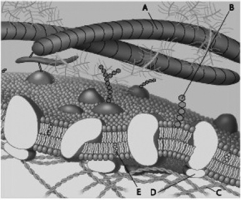
Which component in the accompanying figure is a microfilament (actin filament) of the cytoskeleton?
A) A
B) B
C) C
D) D

Which component in the accompanying figure is a microfilament (actin filament) of the cytoskeleton?
A) A
B) B
C) C
D) D
C
3
Which of the following are least likely to diffuse through the phospholipid bilayer of a cell membrane?
A) large hydrophobic molecules
B) small hydrophobic molecules
C) carbon dioxide
D) small ions
A) large hydrophobic molecules
B) small hydrophobic molecules
C) carbon dioxide
D) small ions
D
4
According to the fluid mosaic model of cell membranes, phospholipids ________.
A) can move laterally along the plane of the membrane
B) frequently flip-flop from one side of the membrane to the other
C) occur in an uninterrupted bilayer, with membrane proteins restricted to the surface of the membrane
D) have hydrophilic tails in the interior of the membrane
A) can move laterally along the plane of the membrane
B) frequently flip-flop from one side of the membrane to the other
C) occur in an uninterrupted bilayer, with membrane proteins restricted to the surface of the membrane
D) have hydrophilic tails in the interior of the membrane

فتح الحزمة
افتح القفل للوصول البطاقات البالغ عددها 68 في هذه المجموعة.
فتح الحزمة
k this deck
5
What kinds of molecules pass through a cell membrane most easily?
A) large and hydrophobic
B) small and hydrophobic
C) large polar
D) small and ionic
A) large and hydrophobic
B) small and hydrophobic
C) large polar
D) small and ionic

فتح الحزمة
افتح القفل للوصول البطاقات البالغ عددها 68 في هذه المجموعة.
فتح الحزمة
k this deck
6
For the following questions, match the labeled component of the cell membrane in the figure with its description.
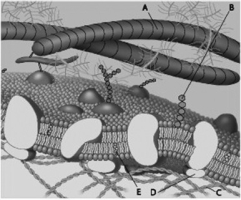
Which component in the accompanying figure plays a critical role in cell-cell recognition?
A) A
B) B
C) C
D) E

Which component in the accompanying figure plays a critical role in cell-cell recognition?
A) A
B) B
C) C
D) E

فتح الحزمة
افتح القفل للوصول البطاقات البالغ عددها 68 في هذه المجموعة.
فتح الحزمة
k this deck
7
Cell membranes have distinct inside and outside faces. Which of the following statements is the most likely explanation for the membrane's asymmetrical nature?
A) Since the cell membrane forms a border between one cell and another in tightly packed tissues such as epithelium, the membrane must be asymmetrical.
B) Since cell membranes communicate signals from one organism to another, the cell membranes must be asymmetrical.
C) The two sides of a cell membrane face different environments and carry out different functions.
D) Proteins only function on the cytoplasmic side of the cell membrane, which results in the membrane's asymmetrical nature.
A) Since the cell membrane forms a border between one cell and another in tightly packed tissues such as epithelium, the membrane must be asymmetrical.
B) Since cell membranes communicate signals from one organism to another, the cell membranes must be asymmetrical.
C) The two sides of a cell membrane face different environments and carry out different functions.
D) Proteins only function on the cytoplasmic side of the cell membrane, which results in the membrane's asymmetrical nature.

فتح الحزمة
افتح القفل للوصول البطاقات البالغ عددها 68 في هذه المجموعة.
فتح الحزمة
k this deck
8
An animal cell lacking carbohydrates on the external surface of its plasma membrane would likely be impaired in which function?
A) transporting ions against an electrochemical gradient
B) cell-cell recognition
C) attaching the plasma membrane to the cytoskeleton
D) establishing a diffusion barrier to charged molecules
A) transporting ions against an electrochemical gradient
B) cell-cell recognition
C) attaching the plasma membrane to the cytoskeleton
D) establishing a diffusion barrier to charged molecules

فتح الحزمة
افتح القفل للوصول البطاقات البالغ عددها 68 في هذه المجموعة.
فتح الحزمة
k this deck
9
The membranes of winter wheat are able to remain fluid when it is extremely cold by ________.
A) increasing the proportion of unsaturated phospholipids in the membrane
B) decreasing the percentage of cholesterol molecules in the membrane
C) decreasing the number of hydrophobic proteins in the membrane
D) increasing the proportion of glycolipids in the membrane
A) increasing the proportion of unsaturated phospholipids in the membrane
B) decreasing the percentage of cholesterol molecules in the membrane
C) decreasing the number of hydrophobic proteins in the membrane
D) increasing the proportion of glycolipids in the membrane

فتح الحزمة
افتح القفل للوصول البطاقات البالغ عددها 68 في هذه المجموعة.
فتح الحزمة
k this deck
10
For the following questions, match the labeled component of the cell membrane in the figure with its description.
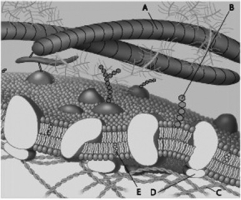
Which component in the accompanying figure is hydrophilic?
A) A
B) B
C) C
D) D

Which component in the accompanying figure is hydrophilic?
A) A
B) B
C) C
D) D

فتح الحزمة
افتح القفل للوصول البطاقات البالغ عددها 68 في هذه المجموعة.
فتح الحزمة
k this deck
11
Which of the following statements describes a characteristic feature of a carrier protein in a plasma membrane?
A) It exhibits specificity for a particular type of molecule.
B) It requires the expenditure of cellular energy to function.
C) It works against diffusion.
D) It has no hydrophobic regions.
A) It exhibits specificity for a particular type of molecule.
B) It requires the expenditure of cellular energy to function.
C) It works against diffusion.
D) It has no hydrophobic regions.

فتح الحزمة
افتح القفل للوصول البطاقات البالغ عددها 68 في هذه المجموعة.
فتح الحزمة
k this deck
12
Which of the following statements is a reasonable explanation for why unsaturated fatty acids help keep a membrane more fluid at lower temperatures?
A) The double bonds form kinks in the fatty acid tails, preventing adjacent lipids from packing tightly.
B) Unsaturated fatty acids have a higher cholesterol content, which prevents adjacent lipids from packing tightly.
C) Unsaturated fatty acids are more nonpolar than saturated fatty acids.
D) The double bonds block interaction among the hydrophilic head groups of the lipids.
A) The double bonds form kinks in the fatty acid tails, preventing adjacent lipids from packing tightly.
B) Unsaturated fatty acids have a higher cholesterol content, which prevents adjacent lipids from packing tightly.
C) Unsaturated fatty acids are more nonpolar than saturated fatty acids.
D) The double bonds block interaction among the hydrophilic head groups of the lipids.

فتح الحزمة
افتح القفل للوصول البطاقات البالغ عددها 68 في هذه المجموعة.
فتح الحزمة
k this deck
13
For the following questions, match the labeled component of the cell membrane in the figure with its description.
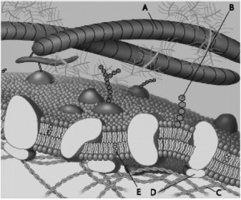
Which component in the accompanying figure is cholesterol?
A) B
B) C
C) D
D) E

Which component in the accompanying figure is cholesterol?
A) B
B) C
C) D
D) E

فتح الحزمة
افتح القفل للوصول البطاقات البالغ عددها 68 في هذه المجموعة.
فتح الحزمة
k this deck
14
Which of the following types of molecules lack hydrophilic domains?
A) transmembrane proteins
B) integral membrane proteins
C) peripheral membrane proteins
D) cholesterol
A) transmembrane proteins
B) integral membrane proteins
C) peripheral membrane proteins
D) cholesterol

فتح الحزمة
افتح القفل للوصول البطاقات البالغ عددها 68 في هذه المجموعة.
فتح الحزمة
k this deck
15
A phospholipid bilayer with equal amounts of saturated and unsaturated fatty acids displays a specific permeability to glucose. What effect will increasing the proportion of unsaturated fatty acids in the bilayer have on the membrane's permeability to glucose?
A) Permeability to glucose will increase.
B) Permeability to glucose will decrease.
C) Permeability to glucose will stay the same.
D) Permeability will decrease initially then increase as the bilayer fills with glucose.
A) Permeability to glucose will increase.
B) Permeability to glucose will decrease.
C) Permeability to glucose will stay the same.
D) Permeability will decrease initially then increase as the bilayer fills with glucose.

فتح الحزمة
افتح القفل للوصول البطاقات البالغ عددها 68 في هذه المجموعة.
فتح الحزمة
k this deck
16
Why are lipids and proteins free to move laterally in membranes?
A) The interior of the membrane is filled with liquid water.
B) Lipids and proteins repulse each other in the membrane.
C) Hydrophilic portions of the lipids are in the interior of the membrane.
D) There are only weak hydrophobic interactions in the interior of the membrane.
A) The interior of the membrane is filled with liquid water.
B) Lipids and proteins repulse each other in the membrane.
C) Hydrophilic portions of the lipids are in the interior of the membrane.
D) There are only weak hydrophobic interactions in the interior of the membrane.

فتح الحزمة
افتح القفل للوصول البطاقات البالغ عددها 68 في هذه المجموعة.
فتح الحزمة
k this deck
17
Which of the following types of molecules are hydrophilic and therefore excluded from the hydrophobic portion of the phospholipid bilayer?
A) transmembrane proteins
B) integral membrane proteins
C) peripheral membrane proteins
D) cholesterol
A) transmembrane proteins
B) integral membrane proteins
C) peripheral membrane proteins
D) cholesterol

فتح الحزمة
افتح القفل للوصول البطاقات البالغ عددها 68 في هذه المجموعة.
فتح الحزمة
k this deck
18
According to the fluid mosaic model, a membrane ________.
A) is composed of a fluid bilayer of phospholipids between two layers of hydrophilic proteins
B) is composed of a single layer of fluid phospholipids between two layers of hydrophilic proteins
C) is composed of a mosaic of fluid polysaccharides and amphipathic proteins
D) is composed of a fluid bilayer of phospholipids with embedded amphipathic proteins
A) is composed of a fluid bilayer of phospholipids between two layers of hydrophilic proteins
B) is composed of a single layer of fluid phospholipids between two layers of hydrophilic proteins
C) is composed of a mosaic of fluid polysaccharides and amphipathic proteins
D) is composed of a fluid bilayer of phospholipids with embedded amphipathic proteins

فتح الحزمة
افتح القفل للوصول البطاقات البالغ عددها 68 في هذه المجموعة.
فتح الحزمة
k this deck
19
For a protein to be an integral membrane protein, it would have to be ________.
A) hydrophilic
B) hydrophobic
C) amphipathic, with at least one hydrophobic region
D) exposed on only one surface of the membrane
A) hydrophilic
B) hydrophobic
C) amphipathic, with at least one hydrophobic region
D) exposed on only one surface of the membrane

فتح الحزمة
افتح القفل للوصول البطاقات البالغ عددها 68 في هذه المجموعة.
فتح الحزمة
k this deck
20
For the following questions, match the labeled component of the cell membrane in the figure with its description.
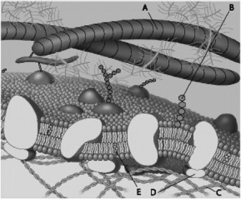
Which component in the accompanying figure is a protein fiber of the extracellular matrix?
A) A
B) B
C) C
D) E

Which component in the accompanying figure is a protein fiber of the extracellular matrix?
A) A
B) B
C) C
D) E

فتح الحزمة
افتح القفل للوصول البطاقات البالغ عددها 68 في هذه المجموعة.
فتح الحزمة
k this deck
21
Five dialysis bags, constructed of a type of membrane that is permeable to water and impermeable to sucrose, were filled with various concentrations of sucrose and then placed in separate beakers containing an initial concentration of 0.6 M sucrose solution. At 10-minute intervals, the bags were massed (weighed), and the percent change in mass of each bag was graphed.
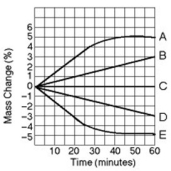
Which line or lines in the graph represent(s) bags that contain a solution that is hypertonic at 50 minutes?
A) A and B
B) B
C) D
D) D and E

Which line or lines in the graph represent(s) bags that contain a solution that is hypertonic at 50 minutes?
A) A and B
B) B
C) D
D) D and E

فتح الحزمة
افتح القفل للوصول البطاقات البالغ عددها 68 في هذه المجموعة.
فتح الحزمة
k this deck
22
Which of the following statements correctly describes osmosis?
A) Osmosis only takes place in red blood cells.
B) Osmosis is an energy-demanding or "active" process.
C) In osmosis, water moves across a membrane from areas of lower solute concentration to areas of higher solute concentration.
D) In osmosis, solutes move across a membrane from areas of lower water concentration to areas of higher water concentration.
A) Osmosis only takes place in red blood cells.
B) Osmosis is an energy-demanding or "active" process.
C) In osmosis, water moves across a membrane from areas of lower solute concentration to areas of higher solute concentration.
D) In osmosis, solutes move across a membrane from areas of lower water concentration to areas of higher water concentration.

فتح الحزمة
افتح القفل للوصول البطاقات البالغ عددها 68 في هذه المجموعة.
فتح الحزمة
k this deck
23
Five dialysis bags, constructed of a type of membrane that is permeable to water and impermeable to sucrose, were filled with various concentrations of sucrose and then placed in separate beakers containing an initial concentration of 0.6 M sucrose solution. At 10-minute intervals, the bags were massed (weighed), and the percent change in mass of each bag was graphed.
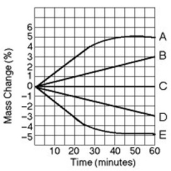
Which line in the graph represents the bag with the highest initial concentration of sucrose?
A) A
B) B
C) C
D) D

Which line in the graph represents the bag with the highest initial concentration of sucrose?
A) A
B) B
C) C
D) D

فتح الحزمة
افتح القفل للوصول البطاقات البالغ عددها 68 في هذه المجموعة.
فتح الحزمة
k this deck
24
Which of the following processes includes all of the others?
A) osmosis
B) facilitated diffusion
C) passive transport
D) transport of an ion down its electrochemical gradient
A) osmosis
B) facilitated diffusion
C) passive transport
D) transport of an ion down its electrochemical gradient

فتح الحزمة
افتح القفل للوصول البطاقات البالغ عددها 68 في هذه المجموعة.
فتح الحزمة
k this deck
25
The solutions in the two arms of this U-tube are separated by a membrane that is permeable to water and glucose but not to sucrose. Side A is half-filled with a solution of 2 M sucrose and 1 M glucose. Side B is half-filled with 1 M sucrose and 2 M glucose. Initially, the liquid levels on both sides are equal.
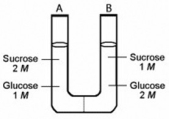
When the system illustrated above reaches equilibrium, the sugar concentrations on both sides of the U-tube will be ________.
A) 2 M sucrose, 1 M glucose
B) 1 M sucrose, 2 M glucose
C) 1 M sucrose, 1 M glucose
D) 1.5 M sucrose, 1.5 M glucose

When the system illustrated above reaches equilibrium, the sugar concentrations on both sides of the U-tube will be ________.
A) 2 M sucrose, 1 M glucose
B) 1 M sucrose, 2 M glucose
C) 1 M sucrose, 1 M glucose
D) 1.5 M sucrose, 1.5 M glucose

فتح الحزمة
افتح القفل للوصول البطاقات البالغ عددها 68 في هذه المجموعة.
فتح الحزمة
k this deck
26
In which of the following environments would there be the greatest need for osmoregulation?
A) an animal connective tissue cell bathed in isotonic body fluid
B) a salmon moving from a river into an ocean
C) a red blood cell surrounded by plasma
D) a plant being grown hydroponically in a watery mixture of designated nutrients
A) an animal connective tissue cell bathed in isotonic body fluid
B) a salmon moving from a river into an ocean
C) a red blood cell surrounded by plasma
D) a plant being grown hydroponically in a watery mixture of designated nutrients

فتح الحزمة
افتح القفل للوصول البطاقات البالغ عددها 68 في هذه المجموعة.
فتح الحزمة
k this deck
27
Which of the following molecules dramatically increases the rate of diffusion of water across cell membranes?
A) the sodium-potassium pump
B) aquaporins
C) gated ion channels
D) ATP
A) the sodium-potassium pump
B) aquaporins
C) gated ion channels
D) ATP

فتح الحزمة
افتح القفل للوصول البطاقات البالغ عددها 68 في هذه المجموعة.
فتح الحزمة
k this deck
28
When a cell is in equilibrium with its environment, which of the following processes occurs for substances that can diffuse through the plasma membrane?
A) There is directed movement of substances into and out of the cell.
B) There is random movement of substances into and out of the cell.
C) There is no movement of substances into or out of the cell.
D) All movement of molecules across the plasma membrane occurs by active transport.
A) There is directed movement of substances into and out of the cell.
B) There is random movement of substances into and out of the cell.
C) There is no movement of substances into or out of the cell.
D) All movement of molecules across the plasma membrane occurs by active transport.

فتح الحزمة
افتح القفل للوصول البطاقات البالغ عددها 68 في هذه المجموعة.
فتح الحزمة
k this deck
29
The solutions in the two arms of this U-tube are separated by a membrane that is permeable to water and glucose but not to sucrose. Side A is half-filled with a solution of 2 M sucrose and 1 M glucose. Side B is half-filled with 1 M sucrose and 2 M glucose. Initially, the liquid levels on both sides are equal.

Which of the following will be true when the system illustrated above reaches equilibrium?
A) The concentration of sucrose on side A will be greater than the concentration of sucrose on side B.
B) The water level will be higher in side A than in side B.
C) The water levels will be unchanged.
D) The water level will be higher in side B than in side A.

Which of the following will be true when the system illustrated above reaches equilibrium?
A) The concentration of sucrose on side A will be greater than the concentration of sucrose on side B.
B) The water level will be higher in side A than in side B.
C) The water levels will be unchanged.
D) The water level will be higher in side B than in side A.

فتح الحزمة
افتح القفل للوصول البطاقات البالغ عددها 68 في هذه المجموعة.
فتح الحزمة
k this deck
30
A research team is working on the design of a new drug for the treatment of lung cancer. To be most effective, this drug must specifically enter the cytoplasm of lung cells while not entering the cells of other tissues. Which of the following characteristics would likely enhance the specificity of this drug?
A) the relative hydrophobicity of the drug molecule
B) phospholipid composition of lung cell plasma membranes
C) specificity of the drug molecule for binding to the extracellular matrix of lung cells
D) similarity of the drug molecule to other molecules normally transported lung cells
A) the relative hydrophobicity of the drug molecule
B) phospholipid composition of lung cell plasma membranes
C) specificity of the drug molecule for binding to the extracellular matrix of lung cells
D) similarity of the drug molecule to other molecules normally transported lung cells

فتح الحزمة
افتح القفل للوصول البطاقات البالغ عددها 68 في هذه المجموعة.
فتح الحزمة
k this deck
31
Which of the following statements correctly describes the normal tonicity conditions for typical plant and animal cells? The animal cell is in ________.
A) a hypotonic solution, and the plant cell is in an isotonic solution
B) an isotonic solution, and the plant cell is in a hypertonic solution
C) a hypertonic solution, and the plant cell is in an isotonic solution
D) an isotonic solution, and the plant cell is in a hypotonic solution
A) a hypotonic solution, and the plant cell is in an isotonic solution
B) an isotonic solution, and the plant cell is in a hypertonic solution
C) a hypertonic solution, and the plant cell is in an isotonic solution
D) an isotonic solution, and the plant cell is in a hypotonic solution

فتح الحزمة
افتح القفل للوصول البطاقات البالغ عددها 68 في هذه المجموعة.
فتح الحزمة
k this deck
32
When a plant cell, such as one from a tulip leaf, is submerged in a hypertonic solution, what is likely to occur?
A) The cell will burst.
B) Plasmolysis will shrink the interior of the cell.
C) The cell will become flaccid.
D) The cell will become turgid.
A) The cell will burst.
B) Plasmolysis will shrink the interior of the cell.
C) The cell will become flaccid.
D) The cell will become turgid.

فتح الحزمة
افتح القفل للوصول البطاقات البالغ عددها 68 في هذه المجموعة.
فتح الحزمة
k this deck
33
Which of the following would likely diffuse through the lipid bilayer of a plasma membrane most rapidly?
A) sucrose
B) an amino acid
C) O₂
D) Na⁺
A) sucrose
B) an amino acid
C) O₂
D) Na⁺

فتح الحزمة
افتح القفل للوصول البطاقات البالغ عددها 68 في هذه المجموعة.
فتح الحزمة
k this deck
34
The solutions in the arms of a U-tube are separated at the bottom of the tube by a selectively permeable membrane. The membrane is permeable to sodium chloride but not to glucose. Side A is filled with a solution of 0.4 M glucose and 0.5 M sodium chloride (NaCl), and side B is filled with a solution containing 0.8 M glucose and 0.4 M sodium chloride. Initially, the volume in both arms is the same.

At the beginning of the U-tube experiment illustrated above, which of the following statements is true?
A) Side A is hypertonic to side B.
B) Side A is hypotonic to side B.
C) Side A is hypertonic to side B with respect to glucose.
D) Side A is hypotonic to side B with respect to NaCl.

At the beginning of the U-tube experiment illustrated above, which of the following statements is true?
A) Side A is hypertonic to side B.
B) Side A is hypotonic to side B.
C) Side A is hypertonic to side B with respect to glucose.
D) Side A is hypotonic to side B with respect to NaCl.

فتح الحزمة
افتح القفل للوصول البطاقات البالغ عددها 68 في هذه المجموعة.
فتح الحزمة
k this deck
35
Celery stalks that are immersed in fresh water for several hours become stiff. Similar stalks left in a 0.15 M salt solution become limp. From this we can deduce that the fresh water ________.
A) and the salt solution are both hypertonic to the cells of the celery stalks
B) is hypotonic and the salt solution is hypertonic to the cells of the celery stalks
C) is hypertonic and the salt solution is hypotonic to the cells of the celery stalks
D) is isotonic and the salt solution is hypertonic to the cells of the celery stalks
A) and the salt solution are both hypertonic to the cells of the celery stalks
B) is hypotonic and the salt solution is hypertonic to the cells of the celery stalks
C) is hypertonic and the salt solution is hypotonic to the cells of the celery stalks
D) is isotonic and the salt solution is hypertonic to the cells of the celery stalks

فتح الحزمة
افتح القفل للوصول البطاقات البالغ عددها 68 في هذه المجموعة.
فتح الحزمة
k this deck
36
Which of the following statements about diffusion is true?
A) It is very rapid over long distances.
B) It requires an expenditure of energy by the cell.
C) It is an active process in which molecules move from a region of lower concentration to a region of higher concentration.
D) It is a passive process in which molecules move from a region of higher concentration to a region of lower concentration.
A) It is very rapid over long distances.
B) It requires an expenditure of energy by the cell.
C) It is an active process in which molecules move from a region of lower concentration to a region of higher concentration.
D) It is a passive process in which molecules move from a region of higher concentration to a region of lower concentration.

فتح الحزمة
افتح القفل للوصول البطاقات البالغ عددها 68 في هذه المجموعة.
فتح الحزمة
k this deck
37
The solutions in the arms of a U-tube are separated at the bottom of the tube by a selectively permeable membrane. The membrane is permeable to sodium chloride but not to glucose. Side A is filled with a solution of 0.4 M glucose and 0.5 M sodium chloride (NaCl), and side B is filled with a solution containing 0.8 M glucose and 0.4 M sodium chloride. Initially, the volume in both arms is the same.
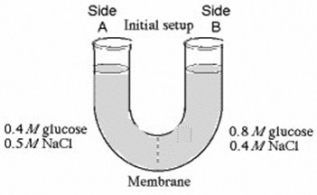
In the U-tube experiment illustrated above, which of the following statements correctly describes side B at equilibrium?
A) The concentration of NaCl and glucose will decrease, and the water level will increase.
B) The concentration of NaCl will increase, the concentration of glucose will decrease, and the water level will increase.
C) The concentration of NaCl will increase, the concentration of glucose will decrease, and the water level will decrease.
D) The concentration of NaCl and glucose will increase, and the water level will decrease.

In the U-tube experiment illustrated above, which of the following statements correctly describes side B at equilibrium?
A) The concentration of NaCl and glucose will decrease, and the water level will increase.
B) The concentration of NaCl will increase, the concentration of glucose will decrease, and the water level will increase.
C) The concentration of NaCl will increase, the concentration of glucose will decrease, and the water level will decrease.
D) The concentration of NaCl and glucose will increase, and the water level will decrease.

فتح الحزمة
افتح القفل للوصول البطاقات البالغ عددها 68 في هذه المجموعة.
فتح الحزمة
k this deck
38
What will happen to a red blood cell (RBC), which has an internal ion content of about 0.9%, if it is placed into a beaker of pure water?
A) The cell would shrink because the water in the beaker is hypotonic relative to the cytoplasm of the RBC.
B) The cell would shrink because the water in the beaker is hypertonic relative to the cytoplasm of the RBC.
C) The cell would swell because the water in the beaker is hypotonic relative to the cytoplasm of the RBC.
D) The cell will remain the same size because the solution outside the cell is isotonic.
A) The cell would shrink because the water in the beaker is hypotonic relative to the cytoplasm of the RBC.
B) The cell would shrink because the water in the beaker is hypertonic relative to the cytoplasm of the RBC.
C) The cell would swell because the water in the beaker is hypotonic relative to the cytoplasm of the RBC.
D) The cell will remain the same size because the solution outside the cell is isotonic.

فتح الحزمة
افتح القفل للوصول البطاقات البالغ عددها 68 في هذه المجموعة.
فتح الحزمة
k this deck
39
Five dialysis bags, constructed of a type of membrane that is permeable to water and impermeable to sucrose, were filled with various concentrations of sucrose and then placed in separate beakers containing an initial concentration of 0.6 M sucrose solution. At 10-minute intervals, the bags were massed (weighed), and the percent change in mass of each bag was graphed.
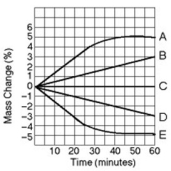
Which line in the graph represents the bag that contained a solution isotonic to the 0.6 M solution at the beginning of the experiment?
A) A
B) B
C) C
D) D

Which line in the graph represents the bag that contained a solution isotonic to the 0.6 M solution at the beginning of the experiment?
A) A
B) B
C) C
D) D

فتح الحزمة
افتح القفل للوصول البطاقات البالغ عددها 68 في هذه المجموعة.
فتح الحزمة
k this deck
40
The solutions in the two arms of this U-tube are separated by a membrane that is permeable to water and glucose but not to sucrose. Side A is half-filled with a solution of 2 M sucrose and 1 M glucose. Side B is half-filled with 1 M sucrose and 2 M glucose. Initially, the liquid levels on both sides are equal.
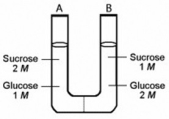
In the U-tube illustrated above, ________.
A) side A is hypertonic to side B
B) side A is hypotonic to side B
C) side A is isotonic to side B
D) side A is more turgid than side B

In the U-tube illustrated above, ________.
A) side A is hypertonic to side B
B) side A is hypotonic to side B
C) side A is isotonic to side B
D) side A is more turgid than side B

فتح الحزمة
افتح القفل للوصول البطاقات البالغ عددها 68 في هذه المجموعة.
فتح الحزمة
k this deck
41
A bacterium engulfed by a white blood cell through phagocytosis will be digested by enzymes contained in ________.
A) lysosomes
B) Golgi vesicles
C) vacuoles
D) secretory vesicles
A) lysosomes
B) Golgi vesicles
C) vacuoles
D) secretory vesicles

فتح الحزمة
افتح القفل للوصول البطاقات البالغ عددها 68 في هذه المجموعة.
فتح الحزمة
k this deck
42
Which of the following membrane activities requires energy from ATP hydrolysis?
A) facilitated diffusion of chloride ions across the membrane through a chloride channel
B) movement of Na⁺ ions from a lower concentration in a mammalian cell to a higher concentration in the extracellular fluid
C) movement of glucose molecules into a bacterial cell from a medium containing a higher concentration of glucose than inside the cell
D) movement of carbon dioxide out of a paramecium
A) facilitated diffusion of chloride ions across the membrane through a chloride channel
B) movement of Na⁺ ions from a lower concentration in a mammalian cell to a higher concentration in the extracellular fluid
C) movement of glucose molecules into a bacterial cell from a medium containing a higher concentration of glucose than inside the cell
D) movement of carbon dioxide out of a paramecium

فتح الحزمة
افتح القفل للوصول البطاقات البالغ عددها 68 في هذه المجموعة.
فتح الحزمة
k this deck
43
Several epidemic microbial diseases of earlier centuries incurred high death rates because they resulted in severe dehydration due to vomiting and diarrhea. Today they are usually not fatal because we have developed which of the following types of treatments?
A) antiviral medications that are efficient and work well with most viruses
B) intravenous feeding techniques
C) medications to slow blood loss
D) hydrating drinks with high concentrations of salt and glucose
A) antiviral medications that are efficient and work well with most viruses
B) intravenous feeding techniques
C) medications to slow blood loss
D) hydrating drinks with high concentrations of salt and glucose

فتح الحزمة
افتح القفل للوصول البطاقات البالغ عددها 68 في هذه المجموعة.
فتح الحزمة
k this deck
44
The force driving simple diffusion is ________, while the energy source for active transport is ________.
A) a concentration gradient; ADP
B) a concentration gradient; ATP hydrolysis
C) transmembrane pumps; an electrochemical gradient
D) phosphorylated carrier proteins; ATP
A) a concentration gradient; ADP
B) a concentration gradient; ATP hydrolysis
C) transmembrane pumps; an electrochemical gradient
D) phosphorylated carrier proteins; ATP

فتح الحزمة
افتح القفل للوصول البطاقات البالغ عددها 68 في هذه المجموعة.
فتح الحزمة
k this deck
45
A patient was involved a serious accident and lost a large quantity of blood. In an attempt to replenish body fluids, distilled water-equal to the volume of blood lost-is added to the blood directly via one of his veins. What will be the most probable result of this transfusion?
A) The patient's red blood cells will shrivel up because the blood has become hypotonic compared to the cells.
B) The patient's red blood cells will swell and possibly burst because the blood has become hypotonic compared to the cells.
C) The patient's red blood cells will shrivel up because the blood has become hypertonic compared to the cells.
D) The patient's red blood cells will burst because the blood has become hypertonic compared to the cells.
A) The patient's red blood cells will shrivel up because the blood has become hypotonic compared to the cells.
B) The patient's red blood cells will swell and possibly burst because the blood has become hypotonic compared to the cells.
C) The patient's red blood cells will shrivel up because the blood has become hypertonic compared to the cells.
D) The patient's red blood cells will burst because the blood has become hypertonic compared to the cells.

فتح الحزمة
افتح القفل للوصول البطاقات البالغ عددها 68 في هذه المجموعة.
فتح الحزمة
k this deck
46
Use the paragraph and accompanying figure to answer the following questions.
Human immunodeficiency virus (HIV) infects cells that have both CD4 and CCR5 cell surface molecules. The viral nucleic acid molecules are enclosed in a protein capsid, and the protein capsid is itself contained inside an envelope consisting of a lipid bilayer membrane and viral glycoproteins. One hypothesis for viral entry into cells is that binding of HIV membrane glycoproteins to CD4 and CCR5 initiates fusion of the HIV membrane with the plasma membrane, releasing the viral capsid into the cytoplasm. An alternative hypothesis is that HIV gains entry into the cell via receptor-mediated endocytosis, and membrane fusion occurs in the endocytotic vesicle. To test these alternative hypotheses for HIV entry, researchers labeled the lipids on the HIV membrane with a red fluorescent dye.
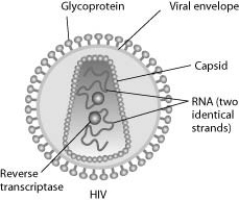
In an HIV-infected cell producing HIV virus particles, the viral glycoprotein is expressed on the plasma membrane. How do the viral glycoproteins get to the plasma membrane? They are synthesized ________.
A) on ribosomes on the plasma membrane
B) by ribosomes in the rough ER and arrive at the plasma membrane in the membrane of secretory vesicles
C) on free cytoplasmic ribosomes and then inserted into the plasma membrane
D) by ribosomes in the rough ER, secreted from the cell, and inserted into the plasma membrane from the outside
Human immunodeficiency virus (HIV) infects cells that have both CD4 and CCR5 cell surface molecules. The viral nucleic acid molecules are enclosed in a protein capsid, and the protein capsid is itself contained inside an envelope consisting of a lipid bilayer membrane and viral glycoproteins. One hypothesis for viral entry into cells is that binding of HIV membrane glycoproteins to CD4 and CCR5 initiates fusion of the HIV membrane with the plasma membrane, releasing the viral capsid into the cytoplasm. An alternative hypothesis is that HIV gains entry into the cell via receptor-mediated endocytosis, and membrane fusion occurs in the endocytotic vesicle. To test these alternative hypotheses for HIV entry, researchers labeled the lipids on the HIV membrane with a red fluorescent dye.

In an HIV-infected cell producing HIV virus particles, the viral glycoprotein is expressed on the plasma membrane. How do the viral glycoproteins get to the plasma membrane? They are synthesized ________.
A) on ribosomes on the plasma membrane
B) by ribosomes in the rough ER and arrive at the plasma membrane in the membrane of secretory vesicles
C) on free cytoplasmic ribosomes and then inserted into the plasma membrane
D) by ribosomes in the rough ER, secreted from the cell, and inserted into the plasma membrane from the outside

فتح الحزمة
افتح القفل للوصول البطاقات البالغ عددها 68 في هذه المجموعة.
فتح الحزمة
k this deck
47
White blood cells engulf bacteria using ________.
A) phagocytosis
B) pinocytosis
C) osmosis
D) receptor-mediated exocytosis
A) phagocytosis
B) pinocytosis
C) osmosis
D) receptor-mediated exocytosis

فتح الحزمة
افتح القفل للوصول البطاقات البالغ عددها 68 في هذه المجموعة.
فتح الحزمة
k this deck
48
Familial hypercholesterolemia is characterized by ________.
A) defective LDL receptors on the cell membranes
B) poor attachment of the cholesterol to the extracellular matrix of cells
C) a poorly formed lipid bilayer that cannot incorporate cholesterol into cell membranes
D) inhibition of the cholesterol active transport system in red blood cells
A) defective LDL receptors on the cell membranes
B) poor attachment of the cholesterol to the extracellular matrix of cells
C) a poorly formed lipid bilayer that cannot incorporate cholesterol into cell membranes
D) inhibition of the cholesterol active transport system in red blood cells

فتح الحزمة
افتح القفل للوصول البطاقات البالغ عددها 68 في هذه المجموعة.
فتح الحزمة
k this deck
49
Which of the following statements is most likely true of a protein that cotransports glucose and sodium ions into the intestinal cells of an animal?
A) Sodium and glucose compete for the same binding site in the cotransporter.
B) Glucose entering the cell down its concentration gradient provides energy for uptake of sodium ions against the electrochemical gradient.
C) Sodium ions can move down their electrochemical gradient through the cotransporter whether or not glucose is present outside the cell.
D) A substance that blocks sodium ions from binding to the cotransport protein will also block the transport of glucose.
A) Sodium and glucose compete for the same binding site in the cotransporter.
B) Glucose entering the cell down its concentration gradient provides energy for uptake of sodium ions against the electrochemical gradient.
C) Sodium ions can move down their electrochemical gradient through the cotransporter whether or not glucose is present outside the cell.
D) A substance that blocks sodium ions from binding to the cotransport protein will also block the transport of glucose.

فتح الحزمة
افتح القفل للوصول البطاقات البالغ عددها 68 في هذه المجموعة.
فتح الحزمة
k this deck
50
The phosphate transport system in bacteria imports phosphate into the cell even when the concentration of phosphate outside the cell is much lower than the cytoplasmic phosphate concentration. Phosphate import depends on a pH gradient across the membrane-more acidic outside the cell than inside the cell. In this bacterial cell, phosphate transport is an example of ________.
A) passive diffusion
B) facilitated diffusion
C) active transport
D) cotransport
A) passive diffusion
B) facilitated diffusion
C) active transport
D) cotransport

فتح الحزمة
افتح القفل للوصول البطاقات البالغ عددها 68 في هذه المجموعة.
فتح الحزمة
k this deck
51
In receptor-mediated endocytosis, receptor molecules initially project to the outside of the cell. Where do they end up after endocytosis?
A) on the outside of vesicles
B) on the inside surface of the cell membrane
C) on the inside surface of the vesicle
D) on the outer surface of the nucleus
A) on the outside of vesicles
B) on the inside surface of the cell membrane
C) on the inside surface of the vesicle
D) on the outer surface of the nucleus

فتح الحزمة
افتح القفل للوصول البطاقات البالغ عددها 68 في هذه المجموعة.
فتح الحزمة
k this deck
52
Which of the following structures would decrease the electrochemical gradient across a membrane?
A) an aquaporin
B) a proton pump
C) a potassium channel
D) both a proton pump and a sodium channel
A) an aquaporin
B) a proton pump
C) a potassium channel
D) both a proton pump and a sodium channel

فتح الحزمة
افتح القفل للوصول البطاقات البالغ عددها 68 في هذه المجموعة.
فتح الحزمة
k this deck
53
Proton pumps are used in various ways by members of every domain of organisms: Bacteria, Archaea, and Eukarya. What does this fact most probably mean?
A) Proton gradients across a membrane were used by cells that were the common ancestor of all three domains of life.
B) The high concentration of protons in the ancient atmosphere must have necessitated a pump mechanism.
C) Cells of each domain evolved proton pumps independently when oceans became more acidic.
D) Proton pumps are necessary to all cell membranes.
A) Proton gradients across a membrane were used by cells that were the common ancestor of all three domains of life.
B) The high concentration of protons in the ancient atmosphere must have necessitated a pump mechanism.
C) Cells of each domain evolved proton pumps independently when oceans became more acidic.
D) Proton pumps are necessary to all cell membranes.

فتح الحزمة
افتح القفل للوصول البطاقات البالغ عددها 68 في هذه المجموعة.
فتح الحزمة
k this deck
54
In some cells, there are many ion electrochemical gradients across the plasma membrane even though there are usually only one or two proton pumps present in the membrane. The gradients of the other ions are most likely accounted for by ________.
A) cotransport proteins
B) ion channels
C) pores in the plasma membrane
D) passive diffusion across the plasma membrane
A) cotransport proteins
B) ion channels
C) pores in the plasma membrane
D) passive diffusion across the plasma membrane

فتح الحزمة
افتح القفل للوصول البطاقات البالغ عددها 68 في هذه المجموعة.
فتح الحزمة
k this deck
55
The sodium-potassium pump is called an electrogenic pump because it ________.
A) pumps equal quantities of Na⁺ and K⁺ across the membrane in opposite directions
B) is used to drive the transport of glucose against a concentration gradient
C) decreases the voltage difference across the membrane
D) generates voltage across the membrane
A) pumps equal quantities of Na⁺ and K⁺ across the membrane in opposite directions
B) is used to drive the transport of glucose against a concentration gradient
C) decreases the voltage difference across the membrane
D) generates voltage across the membrane

فتح الحزمة
افتح القفل للوصول البطاقات البالغ عددها 68 في هذه المجموعة.
فتح الحزمة
k this deck
56
The difference between pinocytosis and receptor-mediated endocytosis is that ________.
A) pinocytosis brings only water molecules into the cell, but receptor-mediated endocytosis brings in other molecules as well
B) pinocytosis increases the surface area of the plasma membrane, whereas receptor-mediated endocytosis decreases the plasma membrane surface area
C) pinocytosis is nonselective in the molecules it brings into the cell, whereas receptor-mediated endocytosis offers more selectivity
D) pinocytosis can concentrate substances from the extracellular fluid, but receptor-mediated endocytosis cannot
A) pinocytosis brings only water molecules into the cell, but receptor-mediated endocytosis brings in other molecules as well
B) pinocytosis increases the surface area of the plasma membrane, whereas receptor-mediated endocytosis decreases the plasma membrane surface area
C) pinocytosis is nonselective in the molecules it brings into the cell, whereas receptor-mediated endocytosis offers more selectivity
D) pinocytosis can concentrate substances from the extracellular fluid, but receptor-mediated endocytosis cannot

فتح الحزمة
افتح القفل للوصول البطاقات البالغ عددها 68 في هذه المجموعة.
فتح الحزمة
k this deck
57
An organism with a cell wall would most likely be unable to take in materials through ________.
A) osmosis
B) active transport
C) phagocytosis
D) facilitated diffusion
A) osmosis
B) active transport
C) phagocytosis
D) facilitated diffusion

فتح الحزمة
افتح القفل للوصول البطاقات البالغ عددها 68 في هذه المجموعة.
فتح الحزمة
k this deck
58
The voltage across a membrane is called the ________.
A) chemical gradient
B) membrane potential
C) osmotic potential
D) electrochemical gradient
A) chemical gradient
B) membrane potential
C) osmotic potential
D) electrochemical gradient

فتح الحزمة
افتح القفل للوصول البطاقات البالغ عددها 68 في هذه المجموعة.
فتح الحزمة
k this deck
59
A sodium-potassium pump ________.
A) moves three potassium ions out of a cell and two sodium ions into a cell while producing ATP for each cycle
B) moves three sodium ions out of a cell and two potassium ions into a cell using energy from ATP hydrolysis
C) moves three potassium ions out of a cell and two sodium ions into a cell using energy from ATP hydrolysis
D) move three sodium ions out of a cell and two potassium ions into a cell and generates an ATP in each cycle
A) moves three potassium ions out of a cell and two sodium ions into a cell while producing ATP for each cycle
B) moves three sodium ions out of a cell and two potassium ions into a cell using energy from ATP hydrolysis
C) moves three potassium ions out of a cell and two sodium ions into a cell using energy from ATP hydrolysis
D) move three sodium ions out of a cell and two potassium ions into a cell and generates an ATP in each cycle

فتح الحزمة
افتح القفل للوصول البطاقات البالغ عددها 68 في هذه المجموعة.
فتح الحزمة
k this deck
60
Diffusion of ions across membranes through specific ion channels is driven by ________.
A) active transport pumps
B) ion concentration gradients only
C) electrical gradients only
D) ion electrochemical gradients
A) active transport pumps
B) ion concentration gradients only
C) electrical gradients only
D) ion electrochemical gradients

فتح الحزمة
افتح القفل للوصول البطاقات البالغ عددها 68 في هذه المجموعة.
فتح الحزمة
k this deck
61
In what way do the membranes of a eukaryotic cell vary?
A) Phospholipids are found only in certain membranes.
B) Certain proteins are unique to each membrane.
C) Only certain membranes of the cell are selectively permeable.
D) Only certain membranes are constructed from amphipathic molecules.
A) Phospholipids are found only in certain membranes.
B) Certain proteins are unique to each membrane.
C) Only certain membranes of the cell are selectively permeable.
D) Only certain membranes are constructed from amphipathic molecules.

فتح الحزمة
افتح القفل للوصول البطاقات البالغ عددها 68 في هذه المجموعة.
فتح الحزمة
k this deck
62
Which of the following factors would tend to increase membrane fluidity?
A) a greater proportion of unsaturated phospholipids
B) a greater proportion of saturated phospholipids
C) a lower temperature
D) a relatively high protein content in the membrane
A) a greater proportion of unsaturated phospholipids
B) a greater proportion of saturated phospholipids
C) a lower temperature
D) a relatively high protein content in the membrane

فتح الحزمة
افتح القفل للوصول البطاقات البالغ عددها 68 في هذه المجموعة.
فتح الحزمة
k this deck
63
Three lab groups carried out an experiment to identify the concentration of sucrose in six solutions. Each unknown contained one of the following sucrose concentrations: 0.0 M, 0.2 M, 0.4 M, 0.6 M, 0.8 M, and 1.0 M. Cubes of sweet potato (1 cm³) were soaked for 24 hours in each solution and weighed to determine the change in mass. Each data entry represents the average of three sample replicates expressed as percent change in mass following a 24-hour soak in the unknown solutions.

Based on the data provided, the intracellular molarity of dissolved solutes in sweet potato cells is approximately ________.
A) 0.2 M
B) 0.4 M
C) 0.6 M
D) 0.8 M

Based on the data provided, the intracellular molarity of dissolved solutes in sweet potato cells is approximately ________.
A) 0.2 M
B) 0.4 M
C) 0.6 M
D) 0.8 M

فتح الحزمة
افتح القفل للوصول البطاقات البالغ عددها 68 في هذه المجموعة.
فتح الحزمة
k this deck
64
Three lab groups carried out an experiment to identify the concentration of sucrose in six solutions. Each unknown contained one of the following sucrose concentrations: 0.0 M, 0.2 M, 0.4 M, 0.6 M, 0.8 M, and -1.0 M. Cubes of sweet potato (1 cm³) were soaked for 24 hours in each solution and weighed to determine the change in mass. Each data entry represents the average of three sample replicates expressed as percent change in mass following a 24-hour soak in the unknown solutions. From the data given, which statement most accurately describes what is occurring in response to a particular unknown solution?

A) Unknown solution E contains the highest concentration of sucrose, and the change in mass is due to the active transport of sucrose out of the cell.
B) Osmosis of water molecules from unknown solution B likely caused the increase in mass observed.
C) Passive transport of sucrose out of the potato cells explains the change in mass observed for unknown solution F.
D) Unknown solution C represents a sucrose concentration slightly higher than the molarity of sweet potato cells, thus water is transported out of the cells.

A) Unknown solution E contains the highest concentration of sucrose, and the change in mass is due to the active transport of sucrose out of the cell.
B) Osmosis of water molecules from unknown solution B likely caused the increase in mass observed.
C) Passive transport of sucrose out of the potato cells explains the change in mass observed for unknown solution F.
D) Unknown solution C represents a sucrose concentration slightly higher than the molarity of sweet potato cells, thus water is transported out of the cells.

فتح الحزمة
افتح القفل للوصول البطاقات البالغ عددها 68 في هذه المجموعة.
فتح الحزمة
k this deck
65
Use the paragraph and accompanying figure to answer the following questions.
Human immunodeficiency virus (HIV) infects cells that have both CD4 and CCR5 cell surface molecules. The viral nucleic acid molecules are enclosed in a protein capsid, and the protein capsid is itself contained inside an envelope consisting of a lipid bilayer membrane and viral glycoproteins. One hypothesis for viral entry into cells is that binding of HIV membrane glycoproteins to CD4 and CCR5 initiates fusion of the HIV membrane with the plasma membrane, releasing the viral capsid into the cytoplasm. An alternative hypothesis is that HIV gains entry into the cell via receptor-mediated endocytosis, and membrane fusion occurs in the endocytotic vesicle. To test these alternative hypotheses for HIV entry, researchers labeled the lipids on the HIV membrane with a red fluorescent dye.

What would be observed by live-cell fluorescence microscopy immediately after HIV entry if HIV is endocytosed first, and then later fuses with the endocytotic vesicle membrane?
A) A spot of red fluorescence will be visible on the infected cell's plasma membrane, marking the site of membrane fusion and HIV entry.
B) The red fluorescent dye-labeled lipids will appear in the infected cell's interior.
C) A spot of red fluorescence will diffuse in the infected cell's cytoplasm.
D) A spot of red fluorescence will remain outside the cell after delivering the viral capsid.
Human immunodeficiency virus (HIV) infects cells that have both CD4 and CCR5 cell surface molecules. The viral nucleic acid molecules are enclosed in a protein capsid, and the protein capsid is itself contained inside an envelope consisting of a lipid bilayer membrane and viral glycoproteins. One hypothesis for viral entry into cells is that binding of HIV membrane glycoproteins to CD4 and CCR5 initiates fusion of the HIV membrane with the plasma membrane, releasing the viral capsid into the cytoplasm. An alternative hypothesis is that HIV gains entry into the cell via receptor-mediated endocytosis, and membrane fusion occurs in the endocytotic vesicle. To test these alternative hypotheses for HIV entry, researchers labeled the lipids on the HIV membrane with a red fluorescent dye.

What would be observed by live-cell fluorescence microscopy immediately after HIV entry if HIV is endocytosed first, and then later fuses with the endocytotic vesicle membrane?
A) A spot of red fluorescence will be visible on the infected cell's plasma membrane, marking the site of membrane fusion and HIV entry.
B) The red fluorescent dye-labeled lipids will appear in the infected cell's interior.
C) A spot of red fluorescence will diffuse in the infected cell's cytoplasm.
D) A spot of red fluorescence will remain outside the cell after delivering the viral capsid.

فتح الحزمة
افتح القفل للوصول البطاقات البالغ عددها 68 في هذه المجموعة.
فتح الحزمة
k this deck
66

Based on Figure 7.18, which of these experimental treatments would increase the rate of sucrose transport into a plant cell?
A) decreasing extracellular sucrose concentration
B) decreasing extracellular pH
C) decreasing cytoplasmic pH
D) adding a substance that makes the membrane more permeable to hydrogen ions

فتح الحزمة
افتح القفل للوصول البطاقات البالغ عددها 68 في هذه المجموعة.
فتح الحزمة
k this deck
67
According to the fluid mosaic model of membrane structure, proteins of the membrane are mostly
A) spread in a continuous layer over the inner and outer surfaces of the membrane.
B) confined to the hydrophobic interior of the membrane.
C) embedded in a lipid bilayer.
D) randomly oriented in the membrane, with no fixed inside-outside polarity.
A) spread in a continuous layer over the inner and outer surfaces of the membrane.
B) confined to the hydrophobic interior of the membrane.
C) embedded in a lipid bilayer.
D) randomly oriented in the membrane, with no fixed inside-outside polarity.

فتح الحزمة
افتح القفل للوصول البطاقات البالغ عددها 68 في هذه المجموعة.
فتح الحزمة
k this deck
68
Which of the following processes includes all the others?
A) osmosis
B) diffusion of a solute across a membrane
C) passive transport
D) transport of an ion down its electrochemical gradient
A) osmosis
B) diffusion of a solute across a membrane
C) passive transport
D) transport of an ion down its electrochemical gradient

فتح الحزمة
افتح القفل للوصول البطاقات البالغ عددها 68 في هذه المجموعة.
فتح الحزمة
k this deck








